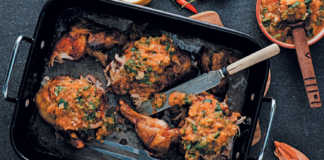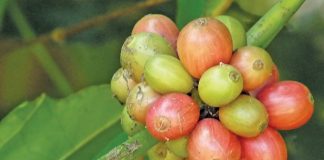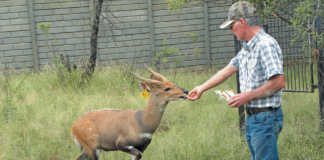
Photo: Glenneis Kriel
For Wakkerstroom farm in the Witzenberg Valley, the 2020 Ceres Fruit Grower Awards was a triumphant affair. In addition to winning a number of trophies for the production of specific apple varieties, it garnered the award for the highest average income per hectare for apples out of the 39 farmer suppliers who participated.
Fourie Zulch, who farms at Wakkerstroom near Ceres with his father, Robert, ascribes their success to the fact that they opt for high packout rates rather than tonnage per hectare.
“Some farmers try to produce as many apples as possible per hectare, thinking that more is better. But overloading trees negatively affects fruit size and quality, which leads to lower income per hectare. We focus instead on creating a balance between quality and quantity.”
Nonetheless, different markets have different standards and requirements. For example, when it comes to Early Red apples, which Wakkerstroom markets mainly locally as Top Red, and Mahana Red, a Braeburn apple mutation sold in South Africa, elsewhere on the continent and in the UK, consumers prefer small fruit at a diameter of around 59mm. So Zulch and his team allow trees of these varieties to produce up to 120t/ha during a good season.
However, varieties aimed at the export market, such as Golden Delicious, Fuji and Kanzi, might have the potential to produce up to 120t/ ha in a good year, but are managed so that they produce only 80t/ha to 90t/ha. This equates to about 320 apples a tree, with an average weight of 150g for Golden Delicious, for instance.
Production management
To perform the balancing act between quality and quantity, the orchards are assessed annually a few weeks after bud break from October onwards, depending on variety, to gauge each one’s production potential for the season.
“Production is influenced by various factors, so we count the number of buds on five or six trees at random in each production unit. We then compare the numbers with historical data to determine whether the unit is heading for a good, average or below-average yield,” says Zulch.
Fertilisation and irrigation are adapted for each orchard based on the seasonal outlook and size requirement for each variety. The trees are pruned and thinned to reduce loads and ensure quality fruit.
Following the harvest in May, old and excess branches are removed to ensure good light penetration into the canopy and maintain the shape of the trees. This is followed by more precise pruning from June to August, which is aimed at rejuvenating growth and preventing the overshadowing of branches and spurs.
Light chemical thinning is done from October to November, while hand-thinning is carried out a few weeks later to prevent too many fruit from forming on each spur. The variety, positioning of the fruit, and the quality of the buds are all taken into consideration when deciding which buds to remove and which to leave.
“With most varieties, we leave about three fruit per spur, but with Kanzi and Fuji we aim for only one, as their stems are short. This helps to prevent stem-end punctures during picking and improves colour formation of these bi-coloured fruit by preventing overshadowing,” Zulch explains.
During the past season, they had to hand-thin Royal Beaut twice, as the variety matured more than a week later than usual, and fruit sizes were smaller than average.
To improve the colour of the fruit in the case of red varieties, particularly the lowest-hanging fruit, Zulch’s team place reflective sheets on the orchard floor four to six weeks before harvesting to reflect sunlight into the trees.
During picking, blemished and damaged apples are kept separate from the rest and sent directly to juicers to prevent unnecessary contact with the good apples. The pickers and sorters are trained to work carefully with the apples and avoid bruising, with production bonuses used as incentives.
Fruit varieties
For the best results, it is not enough to manage the trees; marginal trees must also be replaced over time. The Zulches follow a tight renewal strategy to ensure the financial viability of the orchards, and are aiming for 80% of their 118ha under apple production to be less than 18 years old by 2024.
During orchard replacement, old and problem varieties are replaced by higher-value, improved varieties. Braeburn, for example, has been replaced with Mahana Reds, Royal Gala with Royal Beaut, Fuji with Fuji Royal, and Cripps Pink with Rosy Glow, because of the improved colour development of these new varieties.
In a testimony to their success, Wakkerstroom won trophies for best producer of Mahana Reds, Rosy Glow, Kanzi and Early Red One in the 2020 Ceres Fruit Growers competition.
Two years earlier, Wakkerstroom became the first South African producer to plant the French open variety, Inored, and currently has 6ha under production. Inored has a strong red colour with low sunburn incidence, and long stems, making the fruit easier to pick.
Unlike other full red apples, the flesh does not have a tendency to become mealy-textured. The variety is also one of the first to be resistant to the fungal disease Fusarium.
The Zulches are the owners of Royal Beaut, an improved red Gala strain, which Robert discovered in a Royal Gala orchard at Wakkerstroom in the 1990s. They are also co-owners with Tru- Cape of Fuji Royal, which Robert and Buks Nel of Tru-Cape, who farms in Elgin, discovered around the same time in 2011, each on his own farm.
“We planted our first commercial Fuji Royal in 2018. The fruit has much better colour than Fuji and can be picked clean in one or two goes, which helps reduce labour costs. Fuji has to be picked up to four times because of uneven ripening,” says Zulch.
Rootstocks
Most of the trees on Wakkerstroom have been planted on M7 rootstocks, but dwarfing rootstocks such as M26 and M9 have been used over the past decade to enable higher-density plantings.
Where trees in the past were planted at a spacing of 4,5m by 1,5m, the dwarfing rootstocks allow for densities of up to 3,5m by 0,75m, depending on the terrain.
While most farmers worldwide and locally are embracing M9, Zulch is still not convinced it is the best option for them. One reason is that M9 seems to require more water than M7.
“With rising pressure on water resources, and climate change expected to result in more extreme climatic occurrences, such as droughts and heatwaves, we can’t afford to use plant material that would increase our water footprint,” says Zulch.
He is satisfied with M26 under their production conditions: “The rootstock gives large fruit size and matures fruit early, but we’re probably one of the only farms in the country to use it. We produce our own plant material in our nursery.”
Micro-sprinklers are used to irrigate the full surface of each orchard, and creeping red fescue is planted between the rows in the orchards as a cover crop, primarily to suppress weeds.
All the trees in the new orchards have been trained.
“Trees in higher-density plantings need support to carry fruit, as they’re much thinner than the trees planted at lower densities. The lateral branches of these trees are trained onto the wire and the trees have a much smaller diameter than the lower-density plantings, which improves light penetration and makes them easier to pick. The furthest picking distance, for example, is an elbow’s length. In addition, these orchards require less pruning than the older orchards,” explains Zulch.
In 2018, the Zulches planted their first 3ha of apples under nets, and this year added another 3ha.
“We plant higher-value varieties that ripen later in the season under nets, as the chances are lower that early-ripening varieties will be subjected to ice rain or hail damage. We lost 95% of our harvest because of hail in 2014 and suffered huge losses because of ice rain or hail in 2017, 2018, 2019 and 2020,” says Zulch.
Since he arrived on the farm in 2007, the production of pears has been downscaled. Where there used to be a split of 40% pears and 60% apples, the latter account for 91% of production today.
“The switch to apples is part of our focus to use our land as economically as possible, which boils down to producing the most lucrative crop for our production conditions, in line with what the market wants,” he says.
Email Fourie Zulch at [email protected].











